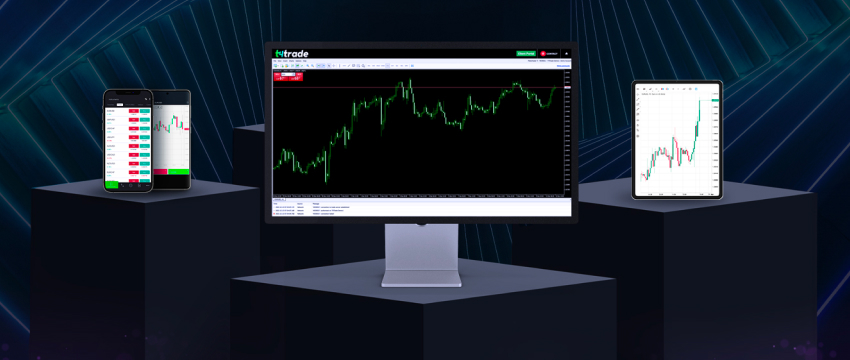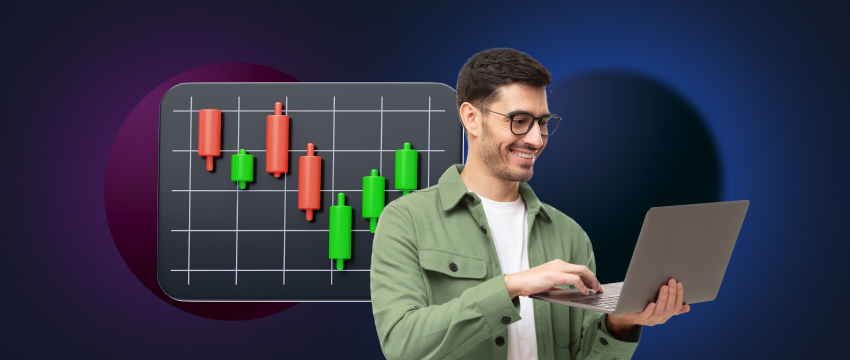There are many choices traders need to make when choosing a forex trading platform, and one of them is which version to use. Terminals, or downloadable versions, are more robust, while web options create more versatility.
Choosing the right mix of these two is up to the forex trader’s needs and habits. Generally, both have their uses, and switching between them based on circumstances is optimal. However, let’s compare these two versions and see when one outperforms the other.
Important: Check whether your forex platform has data sync
Generally, modern brokerages synchronise data between web and downloadable forex platforms. However, in the case that they do not, it might make it much harder for traders who use different platform versions to track their results.
If the broker does not have data sync, that may push traders towards exclusively using either a terminal or web version.
Forex platform performance: Terminals vs web
When talking about performance, it’s largely dependent on the device used to access the trading platform. Traders with particularly strong devices are somewhat unlikely to notice a huge difference in performance between these two versions.
However, even with the strongest device, browsers are always less stable. They are more prone to errors, crashes, lag, and latency issues. As such, terminals will always outperform web versions in this regard.
As noted, this is particularly a prominent issue in weaker devices. There, traders may see significantly more issues with web versions than downloadable ones. This can include choppy handling, freezes, and more.
That could be a particular issue for traders who use fast-paced strategies like scalping. As such, those traders and ones with weaker devices will want to do the vast majority of their trading routine on a trading terminal. This minimises the chances of a trade going awry due to device issues and gives the smoothest possible trading experience.

The difference in features
As the terminal is much more robust, it’s normal that it’ll have more varied features than its web counterpart. The exact features that are cut down for the web version depend on the individual forex platform, but they usually fall under customisation and analysis. Similarly, the intensity of these differences differs based on the trading software, with some being fairly slight and others very noticeable.
However, the deciding factor here, somewhat counterintuitively, isn’t how many features are missing. Let’s say the web trading platform is missing a 5h timeframe that the terminal has. Does that make any difference to a scalper or day trader?
If none of the features traders use regularly are missing, the difference doesn’t really matter. Of course, the possibility to use these features eventually is nice, but when choosing between these two versions, it’s better to consider the current reality rather than theoretical possibilities.
In essence, the platform functionality differences can not matter at all, or make the web version completely unusable. It all depends on what features it cuts out, and how important those features are to the daily routines of the trader using the forex platform.
Mobility and flexibility
Naturally, web platforms will always outperform terminals when it comes to the ability to trade on the move. They are easier to access, take less time, and circumvent any installation blocks on potential trading devices.
However, it’s also important to note that terminals install pretty quickly nowadays, and without many issues. In other words, if a web platform doesn’t suit a trader, it’s fairly easy to just download and open up a terminal. Still, for traders that switch devices often, web is clearly superior.
Another key point in favour of web platforms is what we mentioned earlier, data sync. Sometimes, when you download a terminal on a new device, it doesn’t download your previous trading data, or it takes quite some time to do so. This may create issues with result tracking, and general strategy since it’s difficult to memorise every position without access to account history.
Web platforms, generally, store their data online. That makes it so that every time a trader opens the web platform, they can go on right where they left off. There’s no need to redownload or memorise anything, and all traders need to do is just open the platform.
Security
Once again, the terminal takes the win here. In general, browsers are weaker security-wise than the device running them. As such, the person running the trading platform may want to secure their browser as much as possible.
Additionally, web trading as a whole is less safe if traders do it on public devices. The same also applies to devices connected to public WiFi networks.
Terminals locally store data, making them more secure by default. Additionally, it’s easier to add security to them with tools such as VPNs and firewalls. Again, trading on public networks is not recommended, since that makes a platform much easier to breach, regardless of security protocols.
Upkeep and updates
Here, web platforms are much easier and more intuitive than downloadable ones. Since their latest version is uploaded to the broker’s service and then loaded onto a trader’s browser, web platforms are always up to date.
Conversely, terminals need to be updated constantly, and these updates can cause issues, making traders reinstall the whole thing. In general, this doesn’t pose a significant issue for traders using a terminal on a single device. At worst, it may take around ten minutes of a trader’s day occasionally.
However, for traders who use terminals on multiple devices, this may cause significant frustration. Constantly needing to keep platforms updated, and errors that may happen when accessing different versions of a platform on different devices can be quite tedious.
Web vs terminal: Pros and cons
Let’s take everything covered here and do a little rundown before wrapping everything up.
Web pros
- More versatile: Traders can trade wherever they go, on any device.
- Always up-to-date: There are no updates, web platforms are ready as soon as traders open them.
- Data is always current: Again, there’s no risk of losing data, everything is always synced.
- Usually offers comparable functionality: Modern web platforms perform fairly closely to terminal counterparts.
Web cons
- Less feature-rich: Not all terminal features are supported in web platforms.
- Some important functions may be missing: If an important feature is missing, that may make a web platform borderline unusable.
- More prone to lag, freezes, errors: Browsers are less stable so there’s a higher risk of technical issues.
- Less safe: Limited security options on browsers.
Terminal pros
- Faster: More optimised with less lag and latency.
- Full features: In general, terminals are constructed first and web platforms are derived from them, with the former having a richer feature list.
- Safer: Computers are more secure than browsers in isolation.
- More customisable: Terminal interfaces generally have better customisation support.
Terminal cons:
- Less flexible: Downloading and using a terminal on multiple different devices can present issues
- Manual updates: Traders need to update the software rather than it doing the updates itself.
- Data sync issues: May not synchronise data between different terminals and different platform versions.

Which forex platform to use?
The terminal is definitely the safer option with better performance. However, web platforms shouldn’t be underestimated. For traders with solid devices who don’t use the more complex features of terminals, web options offer a lot of convenience while losing very little functionality. As such, traders should consider their situation, the actual features they use, and how much they move around and choose their preferred option based on that.
Disclaimer: This material is for general informational and educational purposes only and should not be considered investment advice or an investment recommendation. T4Trade is not responsible for any data provided by third parties referenced or hyperlinked in this communication.




